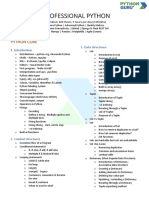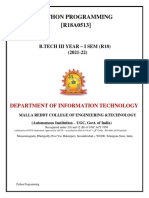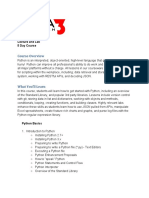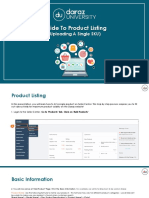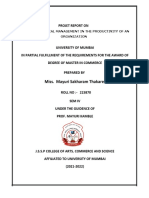Python Mastery Guide: Expanded Edition
This edition expands topics in all chapters, includes all relevant subtopics, and adds code snippets for
exercises and projects.
PART 1: Getting Started
Chapter 1.1: What is Python?
• History and Versions (2.x vs 3.x)
• Python Philosophy (PEP 20 – The Zen of Python)
• Use Cases: Web, Data Science, Automation, Scripting, AI, DevOps
• Python REPL & Interactive Shell
• Jupyter Notebook & IPython
• Package Management: pip, PyPI, virtualenv
Chapter 1.2: Installing Python
• Official installers (Windows, macOS, Linux)
• Version managers (pyenv)
• Anaconda Distribution
• IDE setup: VS Code, PyCharm, Spyder
• PATH and Environment Variables
• Verifying installation and troubleshooting
Chapter 1.3: Your First Script
• Shebang lines and executable scripts
• Running code: CLI vs IDE vs Notebook
• Script arguments ( sys.argv , argparse )
• File encoding and # -*- coding: utf-8 -*-
PART 2: Variables & Data Types
Subtopics:
• Variable naming conventions and rules
• Basic Types: int, float, str, bool, NoneType
• Sequence Types: list, tuple, range
• Text Type: str (methods, slicing, formatting)
• Binary Types: bytes, bytearray, memoryview
• Mapping Type: dict
• Set Types: set, frozenset
• Type casting and conversion
• Type hints, annotations, and typing module
• Literal syntaxes and underscores in numbers
• Constants and immutability
1
� • Dynamic vs static typing discussion
PART 3: Control Flow
Subtopics:
• Conditional statements: if, elif, else
• Ternary expressions
• match / case pattern matching
• Loop types: while, for
• Loop control: break, continue, pass
• else clauses on loops
• Comprehensions: list, dict, set, generator
• Assertions and debugging with pdb
• Context-specific flow: with , exception-driven flow
PART 4: Functions
Subtopics:
• Defining functions with def
• Function parameters: positional, keyword, default, *args , **kwargs
• Return values and multiple returns
• Docstrings and PEP 257 conventions
• Lambda functions
• Higher-order functions (map, filter, reduce)
• Decorators (basic and with parameters)
• Closures and scope (LEGB rule)
• functools: lru_cache , partial , wraps
• Type hints in functions
PART 5: Data Structures
Subtopics:
• List methods and slicing
• Tuples and immutability
• Sets operations: union, intersection, difference, symmetric_difference
• Dictionary methods and iteration patterns
• Collections module: deque, Counter, defaultdict, OrderedDict, namedtuple
• Array module vs list
• heapq for priority queues
• Deque efficiency
• Memoryview for binary data
2
�PART 6: Modules & Packages
Subtopics:
• Module import mechanics ( import , from … import , aliasing)
• Script vs module vs package
• __name__ == "__main__"
• Creating and structuring packages ( __init__.py )
• Relative vs absolute imports
• Distributing packages: setuptools, setup.py , pyproject.toml
• Console scripts and entry points
• Dependency management: pipenv, Poetry, requirements.txt
PART 7: File I/O & Serialization
Subtopics:
• Built-in open modes ( r , w , a , rb , wb )
• Context managers and with statements
• Reading/writing text, lines, binary
• OS module vs pathlib
• CSV handling with csv and pandas
• JSON: json module, custom encoders/decoders
• YAML with PyYAML
• Config files: configparser , .env files
PART 8: Error Handling & Logging
Subtopics:
• Exception hierarchy
• try , except , else , finally
• Raising exceptions and custom exception classes
• Warnings vs errors ( warnings module)
• Context managers for exception suppression ( contextlib.suppress )
• Logging module setup: levels, handlers, formatters
• Integrating logging with exception handling
PART 9: Object-Oriented Programming
Subtopics:
• Classes, instances, attributes, methods
• Encapsulation: public, protected, private attributes
• Inheritance and Method Resolution Order (MRO)
• Polymorphism and duck typing
3
� • Abstract Base Classes ( abc module)
• Data classes and @dataclass
• __slots__ for memory optimization
• Magic methods ( __str__ , __repr__ , __eq__ , etc.)
PART 10: Advanced Python Features
Subtopics:
• Iterators and generators ( __iter__ , __next__ , yield )
• Coroutines and async / await
• Metaclasses and class decorators
• Context managers ( __enter__ , __exit__ , contextlib )
• Descriptor protocol
• Modules: itertools , functools , operator
• Type checking: mypy , typing module, Protocol
PART 11: Testing & Quality Assurance
Subtopics:
• Unit testing with unittest
• pytest fundamentals: fixtures, parametrization
• Mocking with unittest.mock
• Test coverage and coverage.py
• Static analysis: flake8 , pylint , black (formatter)
• Continuous integration basics
PART 12: Real-World Applications
Subtopics:
• Web development: Flask, Django, FastAPI
• Data Science: pandas, numpy, matplotlib, seaborn
• Machine Learning intro: scikit-learn
• Web scraping: requests, BeautifulSoup, Scrapy
• GUI: Tkinter, PySide2, Kivy
• Database access: sqlite3, SQLAlchemy, MongoDB drivers
• Network programming: socket , asyncio streams
• Automation and scripting
4
�PART 13: Practice Projects & Solutions
Projects by Category:
• Beginner: Calculator, To-Do App, Guess the Number (solutions included)
• Intermediate: Expense Tracker, Weather CLI, File Organizer, solutions templates
• Advanced: Web Scraper with DB, Chatbot, Portfolio Website, CI/CD pipeline example
Detailed exercises and code snippets provided for core projects.




























